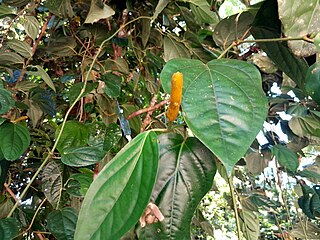
Commelina cyanea, commonly known as scurvy weed, is a perennial prostrate herb of the family Commelinaceae native to moist forests and woodlands of eastern Australia, Lord Howe Island and Norfolk Island. The blue flowers appear over the warmer months and are pollinated by bees and flies.

Olea paniculata, commonly known as the native olive, is a plant of the genus Olea and a relative of the olive. It grows natively in Pakistan and southwestern China (Yunnan) through tropical Asia to Australia and the Pacific islands of New Caledonia, Vanuatu and Lord Howe Island.

Cissus antarctica(synonym Cissus oblongata), called kangaroo vine, is one of the best known species of the genus Cissus in the family of Vitaceae. It is a climbing plant, a vine, and comes from Australia.

Parsonsia straminea, commonly known as common silkpod or monkey rope, is a woody vine of the dogbane family, Apocynaceae. It occurs in the states of New South Wales and Queensland in Australia.

Syzygium hodgkinsoniae is a rare subtropical rainforest tree, growing on alluvial soils by streams in the north east New South Wales and south east Queensland, Australia. The range of natural distribution is from the Richmond River, New South Wales to Gympie in south east Queensland. Common names include smooth-bark rose apple or red lilly pilly.

Endiandra pubens is a rainforest tree growing in eastern Australia. The habitat is subtropical rainforest growing near streams in valleys. The range of natural distribution is from the Bellinger River, New South Wales to Bulburin National Park, south west of Gladstone, Queensland.

Backhousia subargentea is a rare Australian rainforest tree, growing near Mullumbimby in northeastern New South Wales and from Boonah to Imbil in southeastern Queensland.

Psychotria loniceroides, the hairy psychotria, is a plant native to the forest areas of eastern Australia.

Cissus hypoglauca is a common Australian vine. It is one of the better known climbing plants of the genus Cissus in the grape family. A very common climber in moist areas of eastern Australia, it often colonises large areas after forest damage due to storms, fire or logging. Common names include jungle grape, water vine, giant water vine, five-leaf water vine, jungle vine, native grapes and billangai.

Sarcopetalum harveyanum, known as the pearl vine, is a common plant found mostly in coastal areas of eastern Australia. It can be found in or around rainforests, and is also seen in eucalyptus forests.

Endiandra virens is an Australian tree in the laurel family. Growing from Boorganna Nature Reserve north west of Taree, New South Wales to Kin Kin in Southern Queensland. Common names include White Apple, Plumwood, and New South Wales Walnut.

Causonis clematidea, known as the native grape or slender grape, is a common Australian vine in the grape family. Growing in or on the edges of tropical forest, from the Shoalhaven River gorges north to Queensland. Tendrils form opposite the leaf.

Daphnandra johnsonii, also known as the Illawarra socketwood, is a rare rainforest tree in the Illawarra district of eastern Australia.

Pseuderanthemum variabile, commonly known as pastel flower or love flower in its native range, or night and afternoon in the USA, is a small perennial herb in the family Acanthaceae which is native to Australia, Papua New Guinea and New Caledonia. It can be an unwelcome nuisance in orchid nurseries in Australia.

Aristolochia praevenosa, synonym Pararistolochia praevenosa, is an Australian plant in the birthwort family, native to Queensland and New South Wales. The Richmond birdwing butterfly vine grows in subtropical rainforest in coastal areas north from Wollongbar, in far north eastern New South Wales and adjacent areas in south eastern Queensland. It has been recorded as far north as the Mary River. It also grows in tropical north eastern Queensland, where it is a food plant for the Cairns birdwing butterfly.

Myoporum acuminatum, commonly known as waterbush, pointed boobialla or mangrove boobialla, is a flowering plant in the figwort family Scrophulariaceae and is endemic to eastern Australia. It grows in rainforest or wet eucalyptus forest near the coast and in the Coastal Ranges, and is occasionally associated with mangroves. Occasionally it is found in the drier rainforests. It grows naturally as far south as Mimosa Rocks National Park in far south eastern New South Wales, and north to Fraser Island in Southern Queensland.

Oxera splendida is an evergreen vine in the family Lamiaceae which produces white, fragrant flowers and white, egg-shaped fruit. It naturally is occurs in the tropical rain forests of tropical Asia and Australia and is often sighted along rain forest margins such as roads. Some common names include October glory, glory vine, potato vine and fragrant faradaya. Australian indigenous names include Garanggal used from Cairns to Yarrabah, Buku used in the Tully River area, Koie-yan used at Dunk Island and Djungeen used by the Girramay clan.

Trochocarpa thymifolia is a species of flowering plant from the family Ericacae and is endemic to Tasmania. It is a widespread alpine and subalpine shrub with small leaves, pink to red flowers and blue to purple fruit. Originally described by botanist Robert Brown in 1810, it is a widespread Tasmanian endemic that inhabits the state's mountain regions.

Piper mestonii, commonly known as Queensland long pepper or simply long pepper, is an evergreen vine in the pepper family Piperaceae native to rainforests of New Guinea and Queensland, Australia.

Piper interruptum is a vine in the pepper family Piperaceae, native to the eastern parts of Southeast Asia and to Melanesia and Queensland.



















